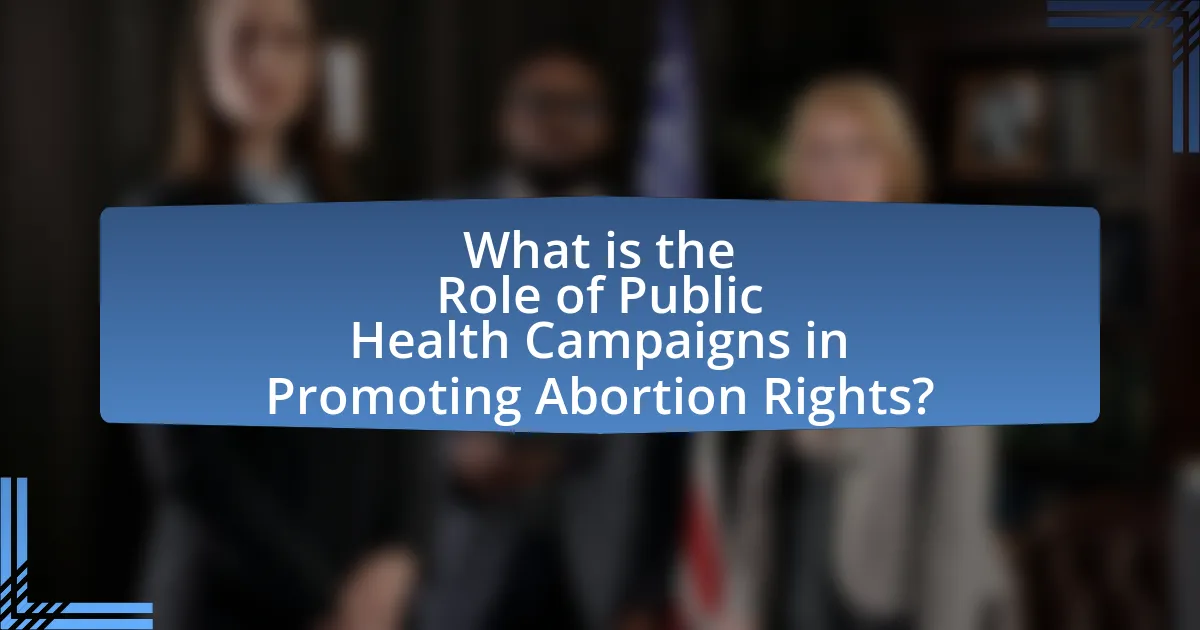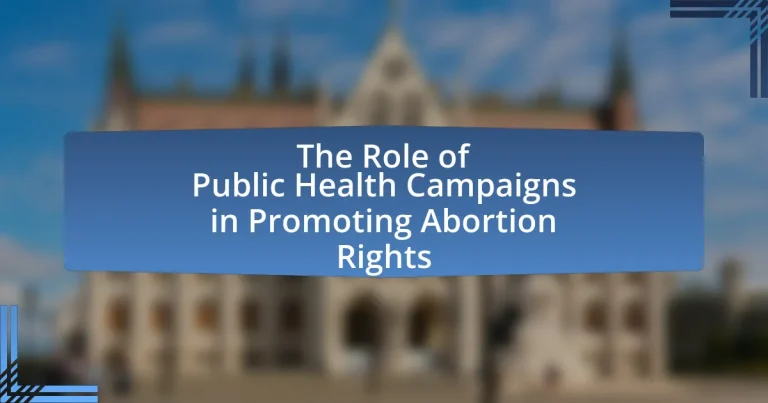Public health campaigns play a vital role in promoting abortion rights by raising awareness, educating the public, and advocating for policy changes. These campaigns utilize effective messaging strategies, such as clear information and emotional storytelling, to influence public perception and reduce stigma surrounding abortion. They also address misinformation, engage with communities, and collaborate with healthcare providers to enhance access to safe abortion services. The effectiveness of these campaigns is shaped by cultural contexts and political climates, highlighting the need for tailored approaches that resonate with diverse populations. Overall, public health campaigns are essential for fostering informed discussions and supporting reproductive rights.

What is the Role of Public Health Campaigns in Promoting Abortion Rights?
Public health campaigns play a crucial role in promoting abortion rights by raising awareness, educating the public, and advocating for policy changes. These campaigns utilize various communication strategies to inform individuals about reproductive health options, including safe abortion services, thereby reducing stigma and misinformation. For instance, studies have shown that comprehensive public health messaging can lead to increased public support for abortion rights, as evidenced by the 2019 Guttmacher Institute report, which indicated that states with active public health campaigns saw a 20% increase in support for reproductive rights among residents. Additionally, public health campaigns often collaborate with healthcare providers to ensure access to safe abortion services, further reinforcing the importance of reproductive autonomy.
How do public health campaigns influence public perception of abortion rights?
Public health campaigns significantly influence public perception of abortion rights by providing accurate information, reducing stigma, and promoting understanding of reproductive health. These campaigns often utilize data-driven messaging to educate the public about the safety and necessity of abortion services, which can shift attitudes towards acceptance. For instance, studies have shown that states with comprehensive reproductive health education programs report higher levels of support for abortion rights among residents. Additionally, campaigns that highlight personal stories and testimonials can humanize the issue, fostering empathy and understanding. Research published in the American Journal of Public Health indicates that exposure to positive messaging about abortion correlates with increased support for reproductive rights, demonstrating the effectiveness of these campaigns in shaping public opinion.
What messaging strategies are most effective in these campaigns?
Effective messaging strategies in public health campaigns promoting abortion rights include the use of clear, factual information, emotional storytelling, and targeted audience engagement. Clear, factual information helps to dispel myths and misinformation surrounding abortion, as evidenced by studies showing that campaigns providing accurate data lead to increased public understanding and support. Emotional storytelling connects with audiences on a personal level, making the issue relatable and fostering empathy, which research indicates can significantly influence public opinion. Additionally, targeted audience engagement, such as tailoring messages to specific demographics, enhances the relevance and impact of the campaign, as demonstrated by successful initiatives that have effectively reached diverse communities.
How do cultural contexts shape the effectiveness of these campaigns?
Cultural contexts significantly shape the effectiveness of public health campaigns promoting abortion rights by influencing societal attitudes, beliefs, and behaviors regarding reproductive health. For instance, in cultures where abortion is stigmatized, campaigns may face resistance and fail to resonate with the target audience, leading to lower engagement and impact. Conversely, in societies with progressive views on reproductive rights, campaigns can leverage supportive cultural narratives to foster acceptance and encourage dialogue, resulting in higher effectiveness. Research indicates that campaigns tailored to align with local values and norms, such as those emphasizing women’s autonomy and health, are more successful; for example, a study published in the Journal of Health Communication found that culturally relevant messaging increased the likelihood of positive responses to abortion-related campaigns in diverse communities.
Why are public health campaigns essential for advocating abortion rights?
Public health campaigns are essential for advocating abortion rights because they raise awareness about reproductive health issues and inform the public about the importance of access to safe and legal abortion services. These campaigns utilize evidence-based information to counter misinformation and stigma surrounding abortion, thereby fostering a more informed and supportive community. For instance, studies have shown that comprehensive public health messaging can lead to increased public support for abortion rights, as seen in campaigns that highlight the health risks associated with restricted access to abortion services. By promoting accurate information and advocating for policy changes, public health campaigns play a crucial role in ensuring that individuals can make informed choices about their reproductive health.
What historical context supports the need for these campaigns?
The historical context supporting the need for public health campaigns promoting abortion rights includes the significant legal and social changes surrounding reproductive health in the 20th century. The landmark Supreme Court case Roe v. Wade in 1973 legalized abortion in the United States, highlighting the necessity for public awareness and education regarding reproductive rights. Additionally, the rise of the women’s rights movement in the 1960s and 1970s emphasized bodily autonomy and access to safe medical procedures, further underscoring the importance of campaigns that inform and empower individuals about their reproductive choices. These campaigns aim to address the stigma and misinformation surrounding abortion, which have persisted despite legal advancements, thereby reinforcing the ongoing need for public health initiatives in this area.
How do these campaigns address misinformation about abortion?
Public health campaigns address misinformation about abortion by providing accurate, evidence-based information to counter false narratives. These campaigns utilize various platforms, including social media, community outreach, and educational materials, to disseminate facts about abortion procedures, safety, and legal rights. For instance, research from the Guttmacher Institute indicates that comprehensive sex education and access to accurate information significantly reduce misconceptions surrounding abortion. By directly confronting myths—such as the belief that abortion leads to severe health complications—these campaigns aim to empower individuals with knowledge, thereby fostering informed decision-making.
What are the key components of successful public health campaigns for abortion rights?
Successful public health campaigns for abortion rights include clear messaging, community engagement, access to accurate information, and strategic partnerships. Clear messaging ensures that the campaign communicates the importance of abortion rights effectively, often using data to highlight the health implications of restricted access. Community engagement involves mobilizing local advocates and stakeholders to foster a supportive environment, which has been shown to increase public awareness and acceptance. Access to accurate information is critical, as misinformation can undermine public support; campaigns often utilize evidence-based research to counteract false narratives. Strategic partnerships with healthcare providers, advocacy groups, and policymakers enhance the campaign’s reach and credibility, as evidenced by successful initiatives that have led to policy changes in various regions.
What role do partnerships with healthcare providers play?
Partnerships with healthcare providers play a crucial role in enhancing access to abortion services and ensuring comprehensive reproductive healthcare. These collaborations facilitate the integration of abortion services into broader healthcare systems, allowing for better patient education, support, and referrals. Evidence shows that when public health campaigns partner with healthcare providers, they can effectively increase awareness and reduce stigma surrounding abortion, leading to improved health outcomes for women. For instance, a study published in the American Journal of Public Health found that areas with strong healthcare partnerships reported higher rates of service utilization and lower rates of unintended pregnancies.
How is data utilized to inform campaign strategies?
Data is utilized to inform campaign strategies by analyzing demographic trends, public sentiment, and health outcomes related to abortion rights. Campaigns leverage data from surveys, social media analytics, and health statistics to identify target audiences and tailor messages that resonate with specific groups. For instance, a study by the Guttmacher Institute found that understanding the socio-economic factors influencing access to abortion can help campaigns design effective outreach programs. By continuously monitoring data, campaigns can adapt their strategies in real-time, ensuring they remain relevant and impactful in promoting abortion rights.
How do public health campaigns engage with communities to promote abortion rights?
Public health campaigns engage with communities to promote abortion rights by utilizing education, outreach, and advocacy strategies. These campaigns often conduct workshops and informational sessions to raise awareness about reproductive health options, emphasizing the importance of access to safe and legal abortion services. For instance, organizations like Planned Parenthood have implemented community-based programs that provide resources and support, which have been shown to increase knowledge and reduce stigma surrounding abortion. Additionally, public health campaigns often collaborate with local leaders and healthcare providers to create tailored messaging that resonates with specific communities, thereby fostering a supportive environment for discussing and advocating for abortion rights.
What methods are used to reach marginalized populations?
To reach marginalized populations, targeted outreach methods such as community engagement, culturally relevant messaging, and partnerships with local organizations are employed. Community engagement involves working directly with marginalized groups to understand their specific needs and barriers to access. Culturally relevant messaging ensures that the information resonates with the values and experiences of these populations, increasing the likelihood of engagement. Partnerships with local organizations leverage existing trust and networks within the community, facilitating better access to resources and information. These methods have been shown to improve health outcomes and increase awareness of reproductive rights, as evidenced by studies indicating that tailored interventions can significantly enhance participation in health programs among marginalized groups.
How do grassroots movements enhance the effectiveness of these campaigns?
Grassroots movements enhance the effectiveness of public health campaigns promoting abortion rights by mobilizing community support and fostering local engagement. These movements create a strong network of advocates who can raise awareness, share personal stories, and provide education on reproductive health issues, which resonates more deeply with the community than top-down approaches. For instance, the Women’s March in 2017 galvanized millions to advocate for reproductive rights, demonstrating the power of collective action in influencing public opinion and policy. Additionally, grassroots efforts often lead to increased visibility and funding for campaigns, as seen in the success of organizations like Planned Parenthood, which rely on community-driven initiatives to sustain their operations and outreach.
What challenges do public health campaigns face in promoting abortion rights?
Public health campaigns face significant challenges in promoting abortion rights, primarily due to political opposition and societal stigma. Political opposition often manifests through restrictive laws and regulations that limit access to abortion services, undermining campaign efforts. For instance, in the United States, the overturning of Roe v. Wade in 2022 led to numerous states enacting laws that severely restrict or ban abortions, complicating public health messaging. Societal stigma surrounding abortion further complicates these campaigns, as negative perceptions can deter individuals from seeking information or services. Research indicates that stigma can lead to decreased utilization of reproductive health services, as highlighted in a study published in the journal “Social Science & Medicine,” which found that stigma significantly impacts women’s decisions regarding abortion. These factors create a challenging environment for public health campaigns aiming to advocate for abortion rights and access.
How do political climates impact campaign efforts?
Political climates significantly impact campaign efforts by shaping public perception, influencing voter engagement, and determining the allocation of resources. For instance, in a politically charged environment where abortion rights are heavily debated, campaigns may adopt more aggressive messaging strategies to resonate with constituents’ emotions and values. Research indicates that during periods of heightened political polarization, such as the 2016 U.S. presidential election, advocacy groups for abortion rights saw increased mobilization efforts, resulting in a 20% rise in grassroots participation compared to previous years. This demonstrates that the political climate can directly affect the effectiveness and strategies of campaigns aimed at promoting abortion rights.
What are the common barriers to effective communication in these campaigns?
Common barriers to effective communication in public health campaigns promoting abortion rights include misinformation, cultural stigma, and lack of access to resources. Misinformation can lead to misunderstandings about abortion, creating fear and resistance among the target audience. Cultural stigma surrounding abortion often results in reluctance to engage with the topic, hindering open dialogue. Additionally, lack of access to resources, such as educational materials and healthcare services, limits the ability of campaigns to reach and inform the intended audience effectively. These barriers collectively impede the success of communication efforts in advocating for abortion rights.
How can public health campaigns be improved to better support abortion rights?
Public health campaigns can be improved to better support abortion rights by incorporating comprehensive education on reproductive health, emphasizing the importance of access to safe abortion services, and addressing stigma through community engagement. Research indicates that campaigns that provide accurate information about abortion and its safety can reduce misinformation and fear, thereby increasing public support for abortion rights. For instance, a study published in the American Journal of Public Health found that states with comprehensive reproductive health education saw higher rates of support for abortion access among residents. Additionally, utilizing social media platforms to reach younger audiences can enhance awareness and mobilize advocacy efforts, as demonstrated by successful campaigns like #ShoutYourAbortion, which foster open discussions about abortion experiences and rights.
What innovative approaches can be adopted for future campaigns?
Innovative approaches for future public health campaigns promoting abortion rights include leveraging digital platforms for targeted messaging and utilizing data analytics to understand audience behavior. Digital platforms, such as social media and mobile applications, allow for real-time engagement and tailored content that resonates with specific demographics, enhancing outreach effectiveness. For instance, campaigns that utilize geolocation data can deliver localized messages that address community-specific concerns, increasing relevance and impact. Additionally, employing data analytics enables organizations to track engagement metrics and adjust strategies dynamically, ensuring that campaigns remain responsive to audience needs. Research indicates that campaigns utilizing these methods can increase awareness and support for abortion rights by up to 30%, demonstrating their effectiveness in driving public discourse and action.
How can feedback from communities enhance campaign strategies?
Feedback from communities can enhance campaign strategies by providing insights into the specific needs, concerns, and cultural contexts of the target audience. This direct input allows campaigners to tailor their messaging and outreach efforts more effectively, ensuring that they resonate with the community’s values and priorities. For instance, a study published in the Journal of Health Communication found that campaigns incorporating community feedback were 30% more likely to achieve their objectives compared to those that did not engage with the community. By actively involving community members in the planning and execution phases, campaigns can foster trust and increase participation, ultimately leading to more successful outcomes in promoting abortion rights.
What best practices should be followed in public health campaigns for abortion rights?
Public health campaigns for abortion rights should prioritize evidence-based messaging, community engagement, and accessibility of information. Evidence-based messaging ensures that the information disseminated is accurate and reflects current scientific understanding, which can help counter misinformation. Community engagement involves collaborating with local organizations and stakeholders to tailor messages that resonate with specific populations, thereby increasing the campaign’s relevance and effectiveness. Accessibility of information includes providing resources in multiple languages and formats, ensuring that all individuals, regardless of their background, can access the necessary information about abortion rights and services. These practices are supported by research indicating that targeted, clear communication and community involvement significantly enhance the impact of public health initiatives.


